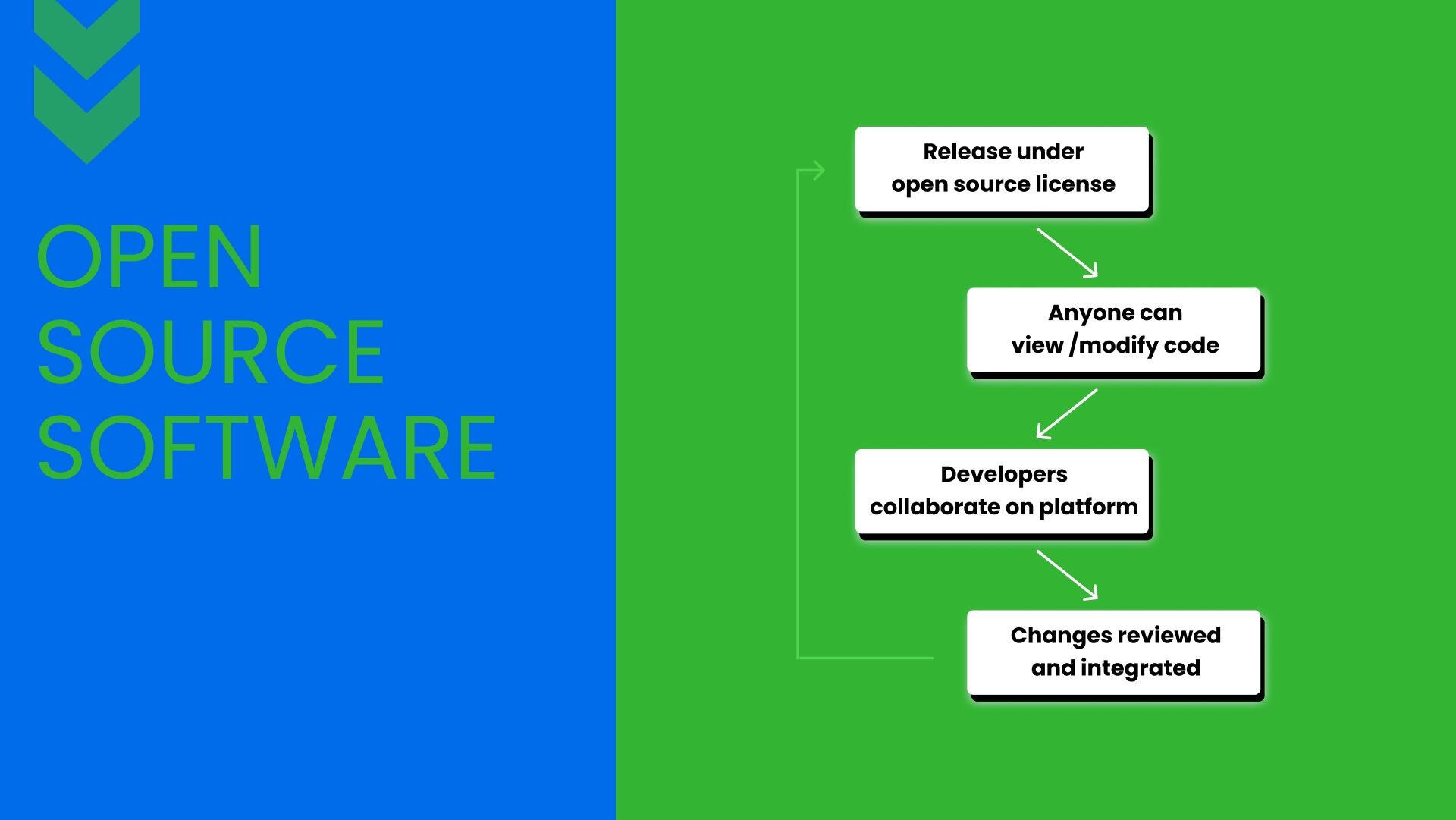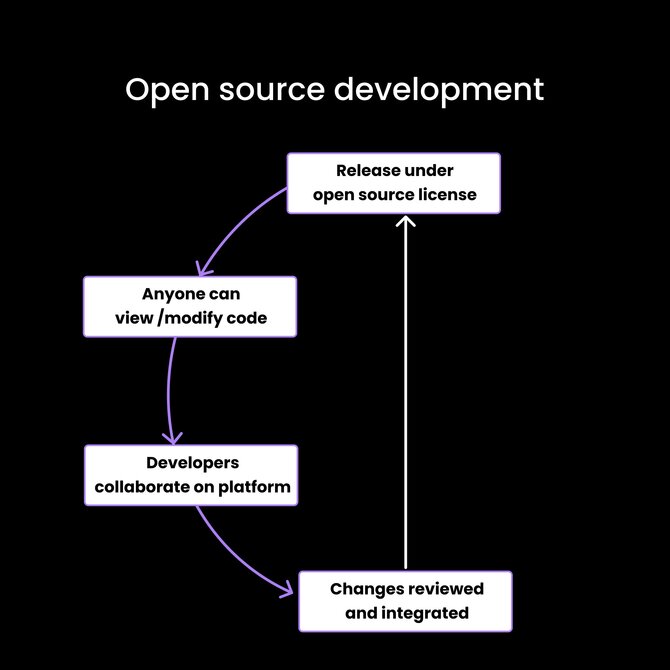
Open Source Software Definition



Glossary Terms


What is open source software?
Open source software is computer software with its source code made available under a license that permits users to study, change, and distribute it to anyone and for any purpose. Source code is the fundamental component of a program that most computer users don't see; it's the code computer programmers can manipulate to change how a piece of software works.
This approach to software development is decentralized and collaborative. It relies on peer review and community production, often resulting in higher quality and more secure software.
Open source software typically offers several advantages over proprietary alternatives:
- Cost-effectiveness
- Flexibility
- Longevity
- Community support
Source code
Source code is the backbone of open source software. It's the human-readable instructions that make up a program written in a programming language. In open source projects, this code is freely accessible to anyone.
Many open source projects host their code on platforms like:
These platforms make it easy for developers to access, fork, and contribute to open source projects.
By making source code freely available, open source software fosters a culture of sharing, learning, and continuous improvement in the tech community.
The origins of open source
The concept of freely available source code dates back to 1983. It emerged from an ideological movement founded by Richard Stallman.
Stallman believed that software should be accessible to programmers, allowing them to modify it as they saw fit. This philosophy laid the groundwork for what we now know as open source.
To put his ideas into practice, Stallman began releasing free code under his own license, called the GNU Public License. This new approach to software creation gained traction over time.
The term "open source" and the broader movement as we know it today took shape in 1998 with the formation of the Open Source Initiative.
How open source development works
The open source development model is the process used by community projects to create open source software. Here's a simplified breakdown of how it typically works:

- Software is released under an open source license
- Anyone can view or modify the source code
- Developers collaborate on platforms like GitHub
- Changes are reviewed and integrated by project maintainers
Many open source projects are hosted on platforms like GitHub. These platforms make it easy for anyone to access repositories or participate in community projects.
Companies like Red Hat have built their business models around creating enterprise-grade products and solutions using the open source development model.
Comparison with proprietary software
Key differences
Open source and proprietary software differ in several key aspects:
- Availability: Open source code is publicly available; proprietary code is not.
- Licensing: Open source licenses are typically free; proprietary software often requires paid licenses.
- Modifications: Open source allows modifications; proprietary software doesn't.
- Customization: Open source is highly customizable; proprietary software often requires change requests to the vendor.
- User interface: Proprietary software often has more polished, user-friendly interfaces.
Proprietary software can limit users' choices, tying them to specific upgrade paths or forcing costly switches to alternative solutions.
The ethical dilemma
While legal, companies taking open source projects, adding features, and selling them without giving back raises ethical questions. This practice challenges the spirit of open source collaboration.
A recent blog post by Builder.io explores this issue, using the example of Cursor building on VS Code to create a paid product.
Impact on innovation
This practice could stifle innovation. When companies close off previously open source projects, they break the chain of community-driven improvements.
The open source community continues to debate how to balance openness, innovation, and sustainability in this complex landscape.
Benefits and values of open source
People often prefer open source software for several reasons:
- Control: Users can examine and modify the code to suit their needs.
- Training: It provides a valuable learning resource for aspiring developers.
- Security: The "many eyes" principle often leads to faster identification and fixing of security issues.
- Stability: Open source projects can outlive companies, ensuring long-term stability.
- Community: OSS often inspires vibrant communities of users and developers.
Open source software exemplifies open collaboration, allowing unlimited contributors to participate in development.
Security and reliability
While open source software can be very secure, it's crucial to manage it effectively:
- Understand what's in your code
- Use software composition analysis tools
- Provide a comprehensive software bill of materials
- Keep track of updates and patches
The broad base of contributors in open source projects often leads to faster identification and fixing of bugs. However, it's important to note that all software will have code flaws regardless of its development model. The main difference lies in who's responsible for fixing these bugs.
Open source projects and communities
Some notable open source projects include:
- Linux: A free, open source operating system released under the GNU General Public License.
- Apache: A widely-used web server that began as a collaborative project.
- TensorFlow: An end-to-end open source platform for machine learning.
- Kubernetes: A cluster management system for containerized applications.
Industry participation
Industry adoption of open source software is on the rise. It's popular in various sectors, including:
- Telecommunications
- Aerospace
- Healthcare
- Media & Entertainment
Companies often turn to OSS for:
- Back-office functionality
- Sales support
- Research and development
- Quick deployment
- Cross-platform compatibility
- Avoiding commercial license management
Red Hat stands out as the world's largest open source company, demonstrating the viability of building a business around open source principles.
Adoption and application
The concept of "open source" has expanded beyond software. It now applies to various fields, including:
- Open-source ecology
- Open content
- Open collaboration
In fact, over 90% of companies use open source components in their proprietary software. The scientific community also favors open source solutions for increased transparency and result validation.
Builder.io's impact in open source
Builder.io has made significant contributions to the open source community through several innovative tools:
- Qwik: A new web framework that delivers instant loading web applications at any size or complexity.
- Partytown: A lazy-loaded library to help relocate resource-intensive scripts into a web worker.
- Mitosis: A tool for writing components once and compiling them into multiple frameworks.
These tools demonstrate Builder.io's commitment to improving web development processes and performance, aligning with the open source philosophy of collaboration and innovation.
RELATED CONTENT
Share this page




Link copied to clipboard!



